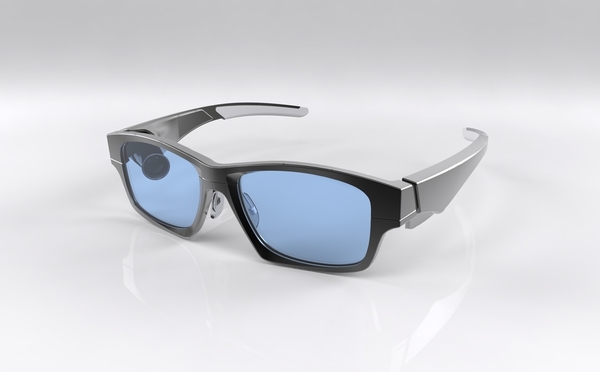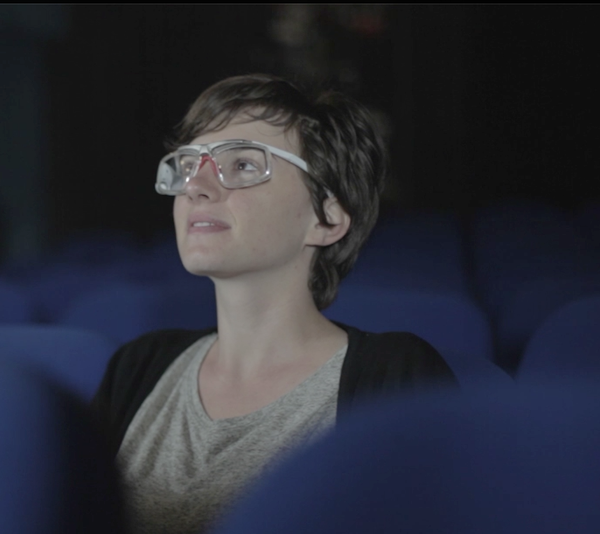A startup from Venice, Italy called GlassUp intends to compete with Google Glass with a pair of glasses that don’t include camera or video capabilities. The prototype is a “receive-only” device that lacks mechanisms for responding to text messages and emails. Its projected screen is monochrome (think old-school UNIX command line) and it places the images near the center field of vision.
When I started writing this I thought I’d do it as sort of a comparison to Google Glass, but after writing that first paragraph it’s pretty clear there’s no comparison. You can’t take photos or videos and you can’t respond to messages with GlassUp. There’s a screen that’s projected right in the center of your field of vision, which Business Insider reported in a way that makes it sound like a good design decision. It’s not. News flash, the reason why the projected screen on Glass is projected slightly to the right of the user’s field of view is because Glass is intended to be unobtrusive; there when you need it but out of the way when you don’t.
Business Insider also seems to think that GlassUp is more discrete than Google Glass and that’s a fair trade off for the lack of a camera, saying “you won’t be able to capture your life as seamlessly real-time, but at least the general public won’t have to worry about you recording them every time you have the glasses on.” That just sounds stupid. “Just as seamlessly” real-time almost makes it sound like the writer understood that there was any capability to capture anything real-time. Remember, it’s a receive-only device. Plus what’s discrete about this?
The thing I love about Glass is that I can capture moments while being in the moment. With Glass I can take a picture or record a video and not have to look through a lens or a pair of glasses while doing it. I simply issue a voice command and Glass does its thing.
GlassUp does not have voice controls like Google Glass. It also requires a Bluetooth connection to display texts and emails, which again you can’t actually respond to via the device. Glass, on the other hand, connects to WiFi so you don’t need a smartphone at all to reap its benefits. In fact, if you’re smart enough to have a Google Voice number you can reply to text messages through Glass using voice commands. You can also have hangouts powered by Google+, that’s free video calls/video conferencing. Something that’s not even in the roadmap for GlassUp.
According to CNet.com, GlassUp could be used for things like real-time feedback displayed for sporting activities, turn-by-turn directions for cyclists, teleprompting, gaming, movie subtitles and real-time translation. But they’re going to need apps for all that stuff. Plus gaming?
Neither Glass nor GlassUp are true Augmented Reality, they’re more consumer augmented reality or as I like to call it AR-Lite. They put 2D projections in 3D space on tiny screens. I don’t see why that would be a compelling proposition to a gamer. I’m not even really into the idea of surfing the web on Glass, though I can if I want to, can’t do that with GlassUp.
When I think about Glass I think of its obvious and immediate implications for things like journalism, education, corporate training and how we experience and share content at the intersection of reality and digitally mediated spaces. When I think about GlassUp… honestly, I get nothing when I think of Glass Up so that just means I’m not impressed.
However, CNet reports that “as a result of its more bare-bones functionality, GlassUp has longer battery life — 150 hours standby and 8 hours of normal usage, the company said — and the cost is lower than Google Glass’ projected consumer pricing,” so there’s that.
While I believe in competition and its potential to spur innovation, I feel there’s a difference between innovating and capitalizing on a trend. And the only reason why that distinction is valid here is because a bunch of people walking, running, cycling with 2D images projected into their center field of view can be dangerous. I hope that wearable computing device makers focus on enhancing real-world experiences and solving practical problems, not just putting computers on our faces.
So far GlassUp has raised $33,536 of its $150,000 on IndieGogo from 191 funders and also claims to have found investors. GlassUp can be purchased from the IndieGogo page for $299 with delivery expected in February of 2014. You can get a prescription version for the low-low price of $399. A camera version is also available for the same price, but there’s no guarantee of what you’ll be able to do with it, that “will depend on the apps that the developer community produce,” the company states on their IndieGogo page.


